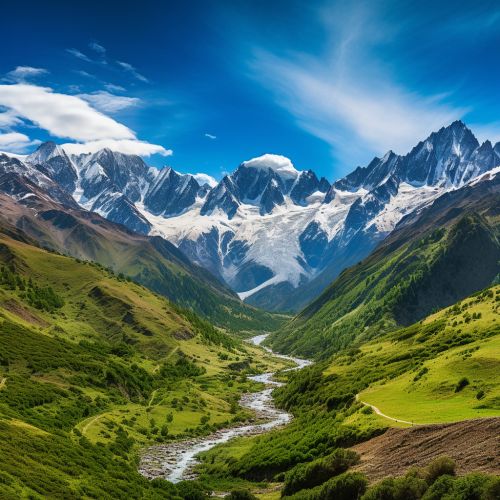Mountain Range
Introduction
A mountain range is a series of mountains or hills ranged in a line and connected by high ground. It is formed through tectonic forces or volcanism. These forces can locally raise the surface of the earth by over 10,000 feet. Most geologists classify a mountain as a landform that rises at least 1,000 feet (300 meters) or more above its surrounding area.


Formation
Mountain ranges are primarily formed by tectonic plate interactions in processes known as orogeny. An orogeny is an event that takes place at a convergent plate boundary when plate movements build up mountains or a mountain range. There are three main types of plate boundary interactions that are associated with the formation of mountain ranges. These are convergent boundaries, divergent boundaries, and transform boundaries.
Convergent Boundaries
At convergent boundaries, tectonic plates collide with each other. This collision can result in one plate being forced beneath another in a process known as subduction. The subducted plate is forced into the mantle where it begins to melt. The magma then rises to the surface to form a chain of volcanoes, which is often seen in island arcs such as the Aleutian Islands in Alaska.
Divergent Boundaries
At divergent boundaries, tectonic plates move apart from each other. As the plates separate, magma rises from the mantle to the surface and new crust is formed. This can result in the formation of a mountain range along the boundary. The Mid-Atlantic Ridge is an example of a mountain range formed by divergent boundaries.
Transform Boundaries
At transform boundaries, tectonic plates slide past each other. This can result in the formation of a mountain range as the plates scrape and push against each other. The San Andreas Fault in California is an example of a mountain range formed by transform boundaries.
Characteristics
Mountain ranges have several defining characteristics. These include the altitude, the volume, the relief, and the steepness of the slopes. The combination of these characteristics contributes to the complexity of the mountain environment.
Altitude
The altitude of a mountain denotes the height of the peak above sea level. The altitude of mountains can vary greatly, from ranges with peaks just a few hundred meters above sea level to those with the highest altitudes, such as the Himalayas, where the peak of Mount Everest reaches over 8,848 meters above sea level.
Volume
The volume of a mountain range refers to the total amount of space that the range occupies. This includes the area covered by the mountains and the space that the mountains displace from the earth's surface.
Relief
The relief of a mountain range refers to the difference in elevation between the highest and lowest points in the range. High relief refers to mountain ranges with a large difference in elevation, while low relief refers to ranges with a smaller difference in elevation.
Slope
The slope of a mountain range refers to the steepness of the mountains. The slope is determined by the change in elevation over a certain distance. Steeper slopes are more challenging to traverse and are often associated with higher mountain ranges.
Major Mountain Ranges
There are numerous major mountain ranges across the world, each with its own unique characteristics and features.
The Himalayas
The Himalayas are the highest mountain range in the world, located in Asia. They stretch across five countries: Bhutan, India, Nepal, China, and Pakistan. The highest peak in the range is Mount Everest, standing at a height of 8,848 meters above sea level.
The Andes
The Andes are the longest continental mountain range in the world, located in South America. They stretch across seven countries: Venezuela, Colombia, Ecuador, Peru, Bolivia, Chile, and Argentina. The highest peak in the range is Mount Aconcagua, standing at a height of 6,962 meters above sea level.
The Rockies
The Rocky Mountains, often referred to as the Rockies, are a significant mountain range located in western North America. They stretch across two countries: the United States and Canada. The highest peak in the range is Mount Elbert, standing at a height of 4,401 meters above sea level.
